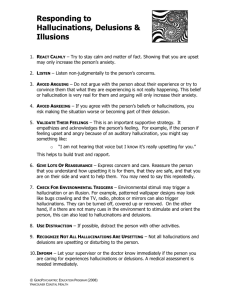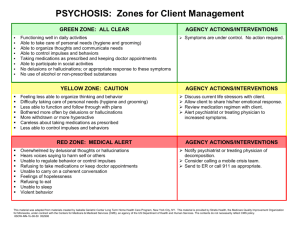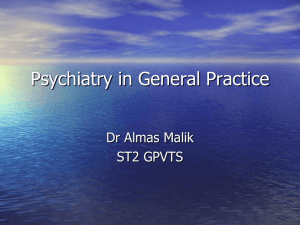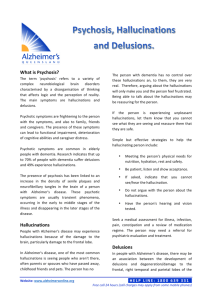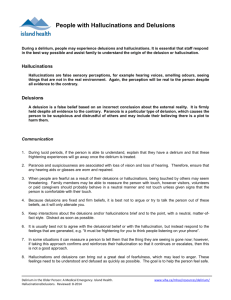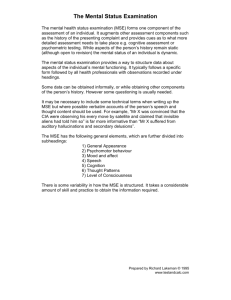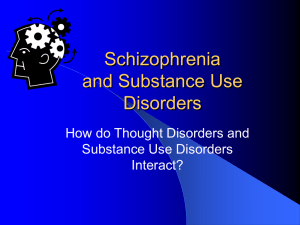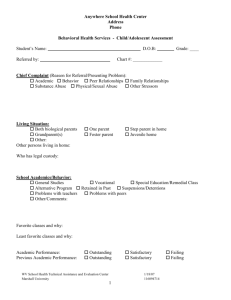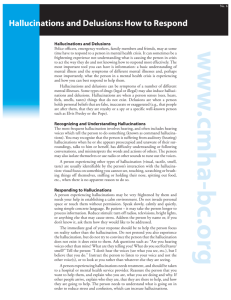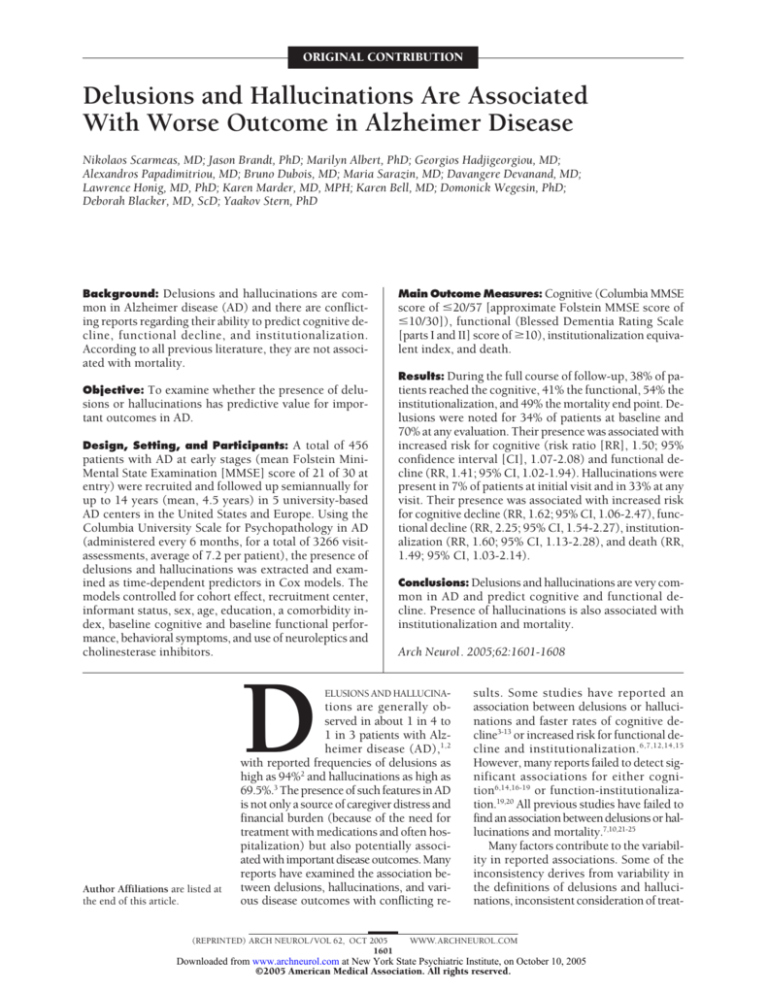
ORIGINAL CONTRIBUTION
Delusions and Hallucinations Are Associated
With Worse Outcome in Alzheimer Disease
Nikolaos Scarmeas, MD; Jason Brandt, PhD; Marilyn Albert, PhD; Georgios Hadjigeorgiou, MD;
Alexandros Papadimitriou, MD; Bruno Dubois, MD; Maria Sarazin, MD; Davangere Devanand, MD;
Lawrence Honig, MD, PhD; Karen Marder, MD, MPH; Karen Bell, MD; Domonick Wegesin, PhD;
Deborah Blacker, MD, ScD; Yaakov Stern, PhD
Background: Delusions and hallucinations are common in Alzheimer disease (AD) and there are conflicting reports regarding their ability to predict cognitive decline, functional decline, and institutionalization.
According to all previous literature, they are not associated with mortality.
Objective: To examine whether the presence of delu-
sions or hallucinations has predictive value for important outcomes in AD.
Design, Setting, and Participants: A total of 456
patients with AD at early stages (mean Folstein MiniMental State Examination [MMSE] score of 21 of 30 at
entry) were recruited and followed up semiannually for
up to 14 years (mean, 4.5 years) in 5 university-based
AD centers in the United States and Europe. Using the
Columbia University Scale for Psychopathology in AD
(administered every 6 months, for a total of 3266 visitassessments, average of 7.2 per patient), the presence of
delusions and hallucinations was extracted and examined as time-dependent predictors in Cox models. The
models controlled for cohort effect, recruitment center,
informant status, sex, age, education, a comorbidity index, baseline cognitive and baseline functional performance, behavioral symptoms, and use of neuroleptics and
cholinesterase inhibitors.
D
Author Affiliations are listed at
the end of this article.
Main Outcome Measures: Cognitive (Columbia MMSE
score of ⱕ20/57 [approximate Folstein MMSE score of
ⱕ10/30]), functional (Blessed Dementia Rating Scale
[parts I and II] score of ⱖ10), institutionalization equivalent index, and death.
Results: During the full course of follow-up, 38% of patients reached the cognitive, 41% the functional, 54% the
institutionalization, and 49% the mortality end point. Delusions were noted for 34% of patients at baseline and
70% at any evaluation. Their presence was associated with
increased risk for cognitive (risk ratio [RR], 1.50; 95%
confidence interval [CI], 1.07-2.08) and functional decline (RR, 1.41; 95% CI, 1.02-1.94). Hallucinations were
present in 7% of patients at initial visit and in 33% at any
visit. Their presence was associated with increased risk
for cognitive decline (RR, 1.62; 95% CI, 1.06-2.47), functional decline (RR, 2.25; 95% CI, 1.54-2.27), institutionalization (RR, 1.60; 95% CI, 1.13-2.28), and death (RR,
1.49; 95% CI, 1.03-2.14).
Conclusions: Delusions and hallucinations are very common in AD and predict cognitive and functional decline. Presence of hallucinations is also associated with
institutionalization and mortality.
Arch Neurol. 2005;62:1601-1608
ELUSIONS AND HALLUCINA-
tions are generally observed in about 1 in 4 to
1 in 3 patients with Alzheimer disease (AD),1,2
with reported frequencies of delusions as
high as 94%2 and hallucinations as high as
69.5%.3 The presence of such features in AD
is not only a source of caregiver distress and
financial burden (because of the need for
treatment with medications and often hospitalization) but also potentially associated with important disease outcomes. Many
reports have examined the association between delusions, hallucinations, and various disease outcomes with conflicting re-
(REPRINTED) ARCH NEUROL / VOL 62, OCT 2005
1601
sults. Some studies have reported an
association between delusions or hallucinations and faster rates of cognitive decline3-13 or increased risk for functional decline and institutionalization.6,7,12,14,15
However, many reports failed to detect significant associations for either cognition6,14,16-19 or function-institutionalization.19,20 All previous studies have failed to
find an association between delusions or hallucinations and mortality.7,10,21-25
Many factors contribute to the variability in reported associations. Some of the
inconsistency derives from variability in
the definitions of delusions and hallucinations, inconsistent consideration of treat-
WWW.ARCHNEUROL.COM
Downloaded from www.archneurol.com at New York State Psychiatric Institute, on October 10, 2005
©2005 American Medical Association. All rights reserved.
ments with neuroleptics, use of standardized scales vs
clinical evaluation, inclusion of subjects at varying stages
of disease, and variable levels of participation and duration of follow-up. Also, many studies considered neuropsychiatric features globally, and only a few reports have
focused on individual subsets (delusions and hallucinations) separately. In addition, most previous studies considered delusions and hallucinations only at a single point
during the course of AD, typically at the baseline visit or
less frequently at any point during the disease course. Because of the progressive nature of AD and the fact that
neuroleptic medications can be effective in managing delusions and hallucinations, these features are not static
and invariable but may fluctuate from visit to visit.13,26-28
Therefore, consideration of delusions or hallucinations
as fixed parameters may lead to biased results.
To investigate these issues, we analyzed data from a
large, multicenter cohort of patients with probable AD
followed from the early stages of the disease for up to 14
years. Standardized assessments of delusions and hallucinations were administered semiannually. We assessed
the association between the presence of these features and
4 outcomes: cognitive end point, functional end point,
institutionalization, and death. Taking advantage of the
multiple assessments of delusions and hallucinations
throughout the course of the disease, we were able to consider their predictive ability in a time-dependent fashion. We also considered the potential effect on the outcome of interest of medications administered for delusions
and hallucinations.
METHODS
PARTICIPANTS
Subjects from 2 Predictors Study cohorts29,30 were included in
these analyses. For the predictors 1 cohort, patients were recruited and studied at 3 sites in the United States: Columbia
University, New York, NY; Johns Hopkins University, Baltimore, Md; and Harvard University, Boston, Mass. For the predictors 2 cohort, in addition to the 2 United States centers, 2
sites in Europe were added: Hospital de la Salpetriere, Paris,
France, and University of Thessaly, Larissa, Greece. The study
was approved by the appropriate local institutional review
boards.
The inclusion and exclusion criteria, as well as the evaluation procedures of the Predictors Study, have been fully described elsewhere.29,30 Briefly, patients met Diagnostic and Statistical Manual of Mental Disorders, Revised Third Edition criteria
for primary degenerative dementia of the Alzheimer type and
National Institute of Neurological Disorders and StrokeAlzheimer Disease and Related Disorders Association criteria
for probable AD. Enrollment required a Columbia MiniMental State Examination (MMSE) score of 30 or more (maximum Columbia MMSE score of 57) which is equivalent to a
score of approximately 16 or more on the Folstein MMSE.31,32
Exclusion criteria were diagnosis of Parkinson disease or parkinsonism at any time prior to the onset of intellectual decline; clinical or historical evidence of stroke; history of alcohol abuse or dependence; any electroconvulsive treatment within
2 years of recruitment or 10 or more electroconvulsive sessions at any time; and history or current clinical evidence of
schizophrenia or schizoaffective disorder that started before the
onset of intellectual decline.
(REPRINTED) ARCH NEUROL / VOL 62, OCT 2005
1602
EVALUATION
At the initial visit, demographic characteristics (such as age,
ethnicity, sex, and education) were recorded and disease severity features were assessed. A physician or a trained research technician administered the Columbia University Scale
for Psychopathology in Alzheimer’s Disease (CUSPAD)33 to
the informant at the initial examination and at 6-month intervals thereafter. Interrater reliabilities between the principal
CUSPAD developer and a research technician (trained by the
principal scale developer) have been reported as follows:
k = 0.77 for delusions and k = 1.00 for hallucinations when
concurrently rating a single interview, and k=0.61 for delusions and k = 0.63 for hallucinations when conducting separate interviews.33
Most CUSPAD items are scored dichotomously (ie, present or absent). For delusions, the categories were general delusions (strange ideas or unusual beliefs); paranoid (people
are stealing things, or unfaithful wife/husband, or unfounded
suspicions); abandonment (accusing caregiver of plotting to
leave him/her); somatic (the patient has cancer or other physical illness); misidentification (people are in the house when
nobody is there, or that someone else is in the mirror, or that
spouse/caregiver is an imposter or that the patient’s house is
not his/her home, or that the characters on television are
real); and a miscellaneous category. A patient was considered
to have delusions if he/she had at least 1 of the previously described types of delusions. Initially, delusions were considered present irrespective of frequency of occurrence (transient [⬍3/week] or persistent [ⱖ3/week]). In subsequent
analyses, we considered a 3-level severity of delusions (absent, transient, or persistent). Four categories of hallucinations were recorded: auditory, visual, tactile, and olfactory.
Patients were considered to have hallucinations if they had
hallucinations in any of the previously mentioned 4 sensory
modalities. Hallucinations were initially included dichotomously (present-absent). In subsequent analyses, we considered a 3-level severity of hallucinations (absent, vague, or
clear). We note here that although it is not clear whether these
symptoms represent truly disturbed ideation vs rooting from
amnestic or perceptual changes in patients with AD, we use
the terms delusions and hallucinations operationally in this
manuscript.
Finally, using CUSPAD items, we constructed a dichotomous variable reflecting whether the patient experienced any
behavioral abnormalities (either confusion, wandering, verbal
outbursts, physical threats, or agitation) at every evaluation.
At every 6-month visit, medications that the patients were taking were recorded. All cholinesterase inhibitors were grouped in
a single category and considered as a dichotomous variable in the
analyses. The same was done for all neuroleptics. We additionally calculated duration of use of neuroleptics for each patient.
A modified version of the Charlson Comorbidity Index34
(herein referred to as the comorbidity index) included items
for myocardial infarct, congestive heart failure, peripheral vascular disease, hypertension, chronic obstructive pulmonary
disease, arthritis, gastrointestinal disease, mild liver disease,
diabetes, chronic renal disease, and systemic malignancy from
initial visit. All items received weights of 1, with the exception
of chronic renal disease and systemic malignancy, which were
weighted 2. No patients with clinical strokes, metastatic
tumors, or AIDS were included in the sample. At baseline
visit, 68% of patients had a comorbidity index of 0, 19% an
index of 1, 8% an index of 2, 4% an index of 3, and 1% an
index of 4. Therefore, dichotomized scores (0 [68%] vs ⱖ1
[32%]) were used. Exploratory use of the index in a trichotomized (0 vs 1 vs ⱖ2) or a continuous form did not change the
results.
WWW.ARCHNEUROL.COM
Downloaded from www.archneurol.com at New York State Psychiatric Institute, on October 10, 2005
©2005 American Medical Association. All rights reserved.
OUTCOMES
Cognitive Outcome
Neurologic and mental status examinations were conducted at
study entry and at 6-month intervals thereafter. The cognitive
function measure used for the analysis was the Columbia MMSE
(in English for the United States sites and in French and Greek
translated versions for the sites in Europe).31,32,35 This is a 57point version of the original Folstein MMSE31 that includes the
addition of digit span forward and backward,36 2 additional calculation items, recall of the current and 4 previous presidents
of the country, confrontation naming of 10 items from the Boston Naming Test,37 1 additional sentence to repeat, and a different copy task including 2 figures. We used a Columbia MMSE
score of 20 out of 57 or less (equivalent to approximately a Folstein MMSE score ⱕ10/30) as the cognitive outcome end point.
This cutoff was chosen because similar scores have been used
as outcomes by many other studies.6,12,38 Exploratory analyses
of neighboring end points (ie, Columbia MMSE ⱕ15 [Folstein MMSE ⱕ8]) did not change the results.
Functional Outcome
Functional capacity was assessed using the Blessed Dementia Rating Scale (BDRS) parts I and II.39 The range is between 0 and 17,
with higher scores indicating worse functional status. We chose
a BDRS score of 10 out of 17 or higher as the functional end point.
The rationale for the functional cutoff was similar to the one described earlier for the cognitive cutoff. Again, exploratory analyses of neighboring BDRS end points gave similar results.
Institutionalization
The equivalent institutional care40 that the patient was receiving was rated at each 6-month follow-up interval. This rating
is the second section of a dependency scale40 that rates the patient’s need for care. It summarizes the interviewer’s impression, based on data from the entire study protocol and of the
care the patient receives and requires, regardless of the patient’s location. Rating categories are limited home care (independent living, with some help in shopping, cooking, or housekeeping, but not with all tasks); adult home (a supervised setting
with regular assistance in shopping, cooking, and housekeeping, and constant companionship, security, legal, or financial
help); and health-related facility (around-the-clock supervision of personal care, safety, or medical care). We used the
equivalent institutional care rating of health-related facility as
an end point for prediction. Interrater reliability for the equivalent institutional care is good, with an intraclass correlation coefficient of 0.73.40 In supplementary analyses, we also used actual (rather than equivalent) placement in either nursing home,
retirement home, or assisted living facility as an outcome.
Death
We typically learned of patients’ deaths from family members
or when attempting to complete follow-up visits. For patients
who could not be contacted for Predictors Study follow-up or
were otherwise lost to follow-up, death information was obtained as available through the National Death Index.
STATISTICAL ANALYSES
Baseline characteristics of patients who did and those who did
not reach the 4 outcomes of interest during the study period
were compared using t test for continuous variables and 2 test
for categorical variables.
We calculated separate Cox proportional hazards models41,42 with the following dichotomous outcomes: cognitive end-
(REPRINTED) ARCH NEUROL / VOL 62, OCT 2005
1603
point, functional endpoint, institutionalization, and death. Duration (in 6-month blocks) between the initial visit and either
development of the outcome or last evaluation without the outcome served as the timing variable in each of the models described earlier. The main predictors in the Cox models were
either hallucinations or delusions, in the form of dichotomous time-dependent covariates. When the 3-level severity form
of delusions or hallucinations were used, it was in the form of
a dummy variable with absence of the symptom as the reference category. The Cox proportional hazards model with timedependent covariates takes into account changes in the status
of the predictor variable at each study visit (eg, a patient may
not have delusions at the first visit but may manifest delusions
at the second and third visit). In subsequent Cox models, we
simultaneously adjusted for the following variables: cohort (first
or second predictors cohort; dichotomous); recruitment center (dummy variable with New York center as the reference);
informant status (dummy variable with spouse as the reference); age at intake in the study; sex; education in years; Columbia MMSE score at initial evaluation; BDRS score at initial
evaluation; and the comorbidity index (dichotomous). Because the ethnic distribution of the patients enrolled in the Predictors Study was heavily weighted toward Caucasians (94%)
with very few African Americans (5%) or other (1%), no
ethnicity variable was included in the models. Neuroleptic medication, cholinesterase inhibitor use, and presence of behavioral abnormalities at each visit were also included as timedependent covariates in the adjusted models. Supplementary
analyses that used duration of use of neuroleptics as a fixed
covariate produced similar results.
RESULTS
Overall, 456 subjects with AD, approximately half from each
predictors cohort, were included in the study (Table 1).
Center recruitment was as follows: New York, 173 (38%);
Baltimore, 118 (26%); Boston, 112 (24%); Paris, 37 (8%);
Larissa, 16 (4%). The majority of patients (88%) were recruited from the 3 centers in the United States. As dictated by the inclusion criteria, patients were at the early
stages of AD at the time of initial recruitment: Columbia
MMSE was 40 (Folstein MMSE of approximately 21). The
subjects were, on average, well educated and in general good
health (as indicated by the fact that approximately two thirds
had a comorbidity index of 0).
Patients were followed from 0.11 to 14 years, during
which there were 3266 visit-assessments of delusions and
hallucinations (on average 7.1, up to 25 per patient). The
informant was usually the spouse or, less likely, the patients’ children. During the period that each subject was
followed, missed visits were rare; fewer than 18% missed
more than 1 semiannual visit and fewer than 9% missed
more than 2. Follow-up information was complete for
94.5% of the cohort, while only 5.5% of the cohort (n=27
subjects) had missing follow-up information for the period of the last year before the most updated data entry.
At the baseline evaluation, delusions were present for
34% (most were transient), while 70% developed delusions at some point during follow-up (most persistent).
Overall, 32 patients (7%) had hallucinations at baseline:
12 (2.4%) auditory, 11 (2%) visual, 9 (2%) olfactory, 2
(0.4%) tactile, and 3 (0.7%) other. Among 130 patients
(33%) who had hallucinations at any time during the followup, 85 (18.7%) had auditory, 108 (23.8%) visual, 20 (4.4%)
WWW.ARCHNEUROL.COM
Downloaded from www.archneurol.com at New York State Psychiatric Institute, on October 10, 2005
©2005 American Medical Association. All rights reserved.
Table 1. Demographic and Clinical Characteristics of Patients
Cohort 1/cohort 2, No. (%)
Mean (SD) duration of follow-up (range), y
Mean (SD) age at study entry (range), y
Mean (SD) education, y
Men/women, No. (%)
Mean (SD) Columbia MMSE at study entry (range)
Mean (SD) Folstein MMSE at study entry (range)
Mean (SD) BDRS at study entry (range)
Comorbidity index 0/comorbidity index ⱖ1, No. (%)
Informant spouse/child/other, No. (%)
Behavioral abnormalities baseline/all evaluations, No. (%)
Delusions, No. (%)
Transient baseline/all evaluations
Persistent baseline/all evaluations
Any baseline/all evaluations
Hallucinations, No. (%)
Vague baseline/all evaluations
Clear baseline/all evaluations
Any baseline/all evaluations
Neuroleptics use, all evaluations, No. (%)
Cholinesterase inhibitor use, all evaluations, No. (%)
Cognitive end point during follow-up, No. (%)
Functional end point during follow-up, No. (%)
Equivalent institutionalization during follow-up, No. (%)
Actual institutionalization, No. (%)
Dead during follow-up, No. (%)
234 (51)/222 (49)
4.5 (3.2) (0.11-14.0)
74 (8.8) (49-99)
13 (3.8) (1-20)
187 (41)/269 (59)
40 (6.1) (30-57)
21 (3.0) (16-30)
3.5 (2.0) (0-13)
310 (68)/146 (32)
231 (53)/141 (32)/67 (15)
211 (47)/374 (82)
91 (20)/90 (20)
65 (14)/227 (50)
156 (34)/317 (70)
12 (3)/52 (12)
20 (4)/103 (23)
32 (7)/150 (33)
140 (28)
182 (41)
171 (38)
186 (41)
234 (54)
168 (38)
224 (49)
Abbreviations: BDRS, Blessed Dementia Rating Scale; MMSE, Mini-Mental State Examination.
Table 2. Cox Models Predicting Occurrence of the 4 Outcomes by Delusions and Hallucinations as Time-Dependent Covariates*
Cognitive
Predictors
RR
(95% CI)
Functional
RR
Institutionalization
(95% CI)
Delusions, transient
Delusions, persistent
Delusions, any
Hallucinations, vague
Hallucinations, clear
Hallucinations, any
1.72†
2.06†
1.91†
1.53
2.48†
2.08†
(1.16-2.54)
(1.46-2.92)
(1.41-2.60)
(0.80-2.93)
(1.58-3.92)
(1.41-3.07)
Unadjusted Models
1.71†
(1.17-2.49)
2.04†
(1.46-2.85)
1.90†
(1.41-2.54)
2.65†
(1.57-4.47)
2.49†
(1.62-3.84)
2.55†
(1.80-3.62)
Delusions, transient
Delusions, persistent
Delusions, any
Hallucinations, vague
Hallucinations, clear
Hallucinations, any
1.42
1.55†
1.50†
1.33
1.77†
1.62†
(0.94-2.14)
(1.07-2.26)
(1.07-2.08)
(0.66-2.69)
(1.09-2.88)
(1.06-2.47)
Adjusted Models‡
1.48
(1.00-2.19)
1.36
(0.94-1.95)
1.41†
(1.02-1.94)
2.62†
(1.52-4.51)
2.04†
(1.28-3.24)
2.25†
(1.54-3.27)
Death
RR
(95% CI)
RR
(95% CI)
1.38
1.87†
1.63†
1.77†
2.06†
1.94†
(0.98-1.93)
(1.39-2.51)
(1.26-2.12)
(1.06-2.96)
(1.38-3.07)
(1.40-2.70)
0.75
0.94
0.86
1.61
1.46
1.52†
(0.50-1.12)
(0.68-1.29)
(0.65-1.13)
(0.97-2.69)
(0.95-2.27)
(1.08-2.15)
1.03
1.07
1.05
1.42
1.74†
1.60†
(0.72-1.47)
(0.77-1.49)
(0.79-1.40)
(0.83-2.41)
(1.14-2.65)
(1.13-2.28)
0.85
0.81
0.83
1.66
1.39
1.49†
(0.56-1.30)
(0.57-1.15)
(0.61-1.12)
(0.97-2.86)
(0.88-2.18)
(1.03-2.14)
Abbreviations: CI, confidence interval; RR, risk ratio.
*Reference is absence of delusions or hallucinations.
†Significant risk ratios (95% CI not including 1).
‡Adjusted models simultaneously controlled for cohort, recruitment center, age, sex, education, baseline Columbia Mini-Mental State Examination, baseline
Blessed Dementia Rating Scale, comorbidity index, informant status, behavioral symptoms, and use of cholinesterase inhibitors and neuroleptics (as
time-dependent covariates).
olfactory, 15 (3.3%) tactile, and 12 (2.6%) other. Therefore, 1 out of 4 to 1 out of 3 of the noted hallucinations
were of visual type. Most hallucinations were clear.
Subjects who were taking neuroleptics (28%) were taking them for 6.9 years (range, 1-14; SD, 4.73). Neuroleptic medication use was associated with higher risk for
reaching the functional end point (risk ratio [RR], 1.68;
95% confidence interval [CI], 1.12-2.50) and for insti(REPRINTED) ARCH NEUROL / VOL 62, OCT 2005
1604
tutionalization (RR, 1.75; 95% CI, 1.17-2.62). There was
no association with the cognitive outcome (RR, 0.90; 95%
CI, 0.55-1.48) or with mortality (RR, 1.26; 95% CI, 0.891.77).
Presence of both delusions and hallucinations were
associated with increased risk of reaching both the cognitive and the functional outcomes in both unadjusted
and adjusted models (Table 2).
WWW.ARCHNEUROL.COM
Downloaded from www.archneurol.com at New York State Psychiatric Institute, on October 10, 2005
©2005 American Medical Association. All rights reserved.
More than half of the patients (54%) reached the
equivalent institutional care end point. Although both
delusions and hallucinations were associated with risk
for reaching this end point at the unadjusted models, delusions were not a significant predictor in the adjusted
models (Table 2). On the contrary, presence of hallucinations was associated with a 1.6-time higher risk of reaching the institutionalization end point in the adjusted models. Overall, 38% of patients were actually placed in either
a nursing home, retirement home, or assisted living facility. Use of actual placement as the outcome produced
similar results.
Almost half the patients died during the follow-up period. Median survival from recruitment into the study was
6.6 years (95% CI, 6.0-7.2). Delusions were not a significant predictor of mortality in any of the models (Table 2).
There was a significant association between hallucinations and mortality risk in both the adjusted and unadjusted models; presence of hallucinations was associated
with an approximately 1.5-time higher risk of death.
For most of the outcomes and in both adjusted and
unadjusted models, the associations were stronger for persistent delusions. There was no clear pattern for hallucinations, with associations being stronger for clear hallucinations for some outcomes and vague hallucinations
for others.
Autopsy data were available for 96 patients; 93% had
AD-type pathological changes (87% received the pathological diagnosis of AD and 6% had senile changes of the
Alzheimer type). Dementia with Lewy bodies was diagnosed in 22% (coexisting with AD-type changes in all but
1 patient). Excluding subjects with pathological dementia with Lewy bodies diagnoses from the analyses did not
change the associations between neuropsychiatric symptoms and outcomes. Comparing patients with and without pathological diagnosis of dementia with Lewy bodies, there was no difference in proportions reaching the
cognitive outcome (P=.91), functional outcome (P=.11),
institutionalization (P= .64), or mortality (P= .98). Additionally, there was no difference in proportions of baseline delusions (P= .73), delusions at any visit (P=.12),
baseline hallucinations (P= .38), baseline visual hallucinations (P=.48), hallucinations at any visit (P=.31), or
visual hallucinations at any visit (P= .31). To further explore associations between Lewy body pathology and clinical indices, we combined extrapyramidal signs with hallucinations. Using presence of severe extrapyramidal signs
(Unified Parkinson’s Disease Rating Scale score ⬎1 at any
motor domain) at any visit and presence of hallucinations at any visit, we constructed a 3-level categorical variable: absence of both, presence of 1 out 2, and presence
of both. There was no association between this variable
and neuropathological diagnosis of dementia with Lewy
bodies (P=.21). Using a combination of extrapyramidal
signs and visual hallucinations at any visit produced similar results (P=.18).
COMMENT
In this study, both delusions and hallucinations were associated with higher risk for cognitive and functional de(REPRINTED) ARCH NEUROL / VOL 62, OCT 2005
1605
cline in patients with AD. For both of these outcomes,
the risk ratio associated with hallucinations was stronger than that for delusions. Persistent nature of delusions conferred a somehow higher risk, while clarity or
vagueness of hallucinations did not seem to provide additional prognostic information. Presence of hallucinations was also associated with higher risk of institutionalization and death. All these associations were significant
even after adjusting for multiple potential confounders.
We confirmed the associations of the assessed neuropsychiatric symptoms with functional decline and institutionalization that have been noted in previous studies, including those that used part of the predictors 1
cohort.22,43 However, these new results additionally show
a previously unobserved association between hallucinations and both cognitive decline and mortality. There are
several explanations for this additional finding. The present analyses are much more powerful since we included
more than twice as many patients with AD with data from
an additional 6 to 8 years of follow-up. Data from 2 centers in Europe were also included improving the generalizability of the findings. We examined delusions and
hallucinations separately. We also controlled for additional covariates such as medications and comorbid diseases. Most importantly, we used a time-dependent approach in the analyses.
Survival in our study was very close to a recent report including patients with AD with similar disease severity at enrollment.25 However, to our knowledge, this
is the first study reporting that hallucinations carry a significant risk for death in AD. Hallucinations may reflect
higher burden or more biologically detrimental localization of neuropathology. They may also be associated with
more risk-taking behavior or lower attention to medical
problems that could eventually lead to mortality.
There was a disparity between presence of delusions
(70%) and treatment with neuroleptics (28%). This may
relate to clinical decision processes that take into account not only presence but also the severity and persistence of the symptoms; whether the behavior seems
disruptive for the patient and the family; possible medication intolerance and side effects; presence of supportive and involved caregiver environment; and possible use
of other classes of medication to control behavior. The
noted association between hallucinations and increased
risk for death was not confounded by medication effects. Antipsychotic medications may affect the natural
course of AD since they have been associated with poor
outcomes6 and more recently with increased risk for
stroke.44 In our analyses, use of antipsychotic medications was associated with increased risk for functional
outcome and institutionalization but not cognitive outcome or mortality. The noted association with risk for
functional abnormalities and institutionalization could
be related to motor abnormalities or increased sedation
that often occur in subjects taking these medications.
Studies on the relation between psychiatric symptoms and presence of Lewy bodies have produced mixed
results with some studies reporting significant associations45-47 and some (including a previous study from the
present population)48 reporting no associations.48-50 Even
with this larger sample, we detected no associations beWWW.ARCHNEUROL.COM
Downloaded from www.archneurol.com at New York State Psychiatric Institute, on October 10, 2005
©2005 American Medical Association. All rights reserved.
tween either delusions or hallucinations and presence of
Lewy bodies. The physiological changes underlying the
emergence of neuropsychiatric symptoms in AD is far from
clear. Delusions or hallucinations in AD have been associated with increased neocortical51,52 and prosubiculum52 neurofibrillary tangles and senile plaque52 densities and lower neuronal counts in the CA1 area of the
hippocampus.53 Associations between these neuropsychiatric symptoms in AD and lower cell counts in the dorsal raphe nucleus,53 reduced levels of serotonin and 5-hydroxyindoleacetic acid,52 and polymorphic variations in
5-HT2A and 5-HT2C54 have suggested a possible role of
the serotoninergic system.55 Delusions and hallucinations have been associated with either no changes in the
locus coeruleus neunonal counts53 or preservation of norepinephrine in the substantia nigra52 leaving the link with
the adrenergic system still unclear.56 Finally, associations between psychotic behavior and dopaminergic receptor DRD1, DRD2, and DRD3 polymorphisms have also
been reported.57
The noted frequencies of both delusions and hallucinations were within previously reported ranges.1-3 It is
important to note the discrepancy between the frequency of delusions and hallucinations between the first
and all subsequent evaluations. For example, only about
half of patients who had delusions at some point during
the follow-up had them at first visit. Among patients who
had hallucinations, only less than a quarter had them at
baseline evaluation. These results likely relate to both an
increasing prevalence of these symptoms during the course
of disease and to the well-described phenomenon of fluctuations of these symptoms from visit to visit.13,26-28 Therefore, the usual approach of considering the presence of
these symptoms only at baseline could be one of the major explanations for discrepant predictive ability results
in the literature.
Our results confirm those of many previous studies that
noted increased risk for cognitive decline3-12 and functional decline/institutionalization6,7,14,15 for hallucinations and partially for delusions. One major milestone in
the progression of dementia is admission to a skilled nursing facility. In our sample, 66 patients (15%) were still at
home despite having reached the equivalent institutional
care outcome. Decision for institutionalization in real life
is influenced by factors other than the severity of dementia. Such nonmedical factors include existence of living family members, willingness and ability of the family to provide care, geographic location of family, financial and
insurance status, cultural beliefs, and other factors. Thus,
actual institutional placement is not always a good proxy
for a patient’s true level of dependence or need for care.
We used the equivalent institutional care, which provides a more uniform and objective assessment of the factors mentioned earlier. The associations between either actual or equivalent institutionalization and neuropsychiatric
symptoms were similar.
This study has limitations. Patients with AD were selected from tertiary care university hospitals and specialized diagnostic and treatment centers and thus represent a nonrandom sample of those affected by AD in
the population. In addition, the proportion of African
Americans and Hispanics in our sample was very small.
(REPRINTED) ARCH NEUROL / VOL 62, OCT 2005
1606
Therefore our results might not be generalized to population-based AD and all ethnicities. Although we used survival analyses, which take advantage of variable follow-up times, a longer average duration of follow-up may
have provided a more complete conclusion. This could
have been achieved with enrollment of patients at even
earlier stages of their disease or even before symptom onset; however, it is not clear that this would change the
results since delusions and hallucinations are usually absent early on. Because prominent language difficulties may
interact with the Columbia MMSE scores, results pertaining to the cognitive outcome may not fully apply to
such subpopulation of patients with AD. Medication use
was coded in a dichotomous fashion. Although we used
a time-dependent approach for the medication covariate, we cannot completely take into account the potential effect of various types of neuroleptics, differential
doses, alterations in prescriptions occurring in intervals
shorter than 6 months, or even response of symptoms
to these medications.
In general, confidence in our findings is strengthened by several factors. To our knowledge, this is the largest study of its kind examining the issue of hallucinations in AD, supplying enough power for detection and
more precise calculation of effects of interest and ability
to control for potential confounders. A major contribution of the present analyses lies in the careful diagnosis
and clinical follow-up that patients received. Clinical diagnosis took place in university hospitals with specific
expertise in dementia and was based on uniform application of widely accepted criteria via consensus diagnostic conference procedures. The clinical diagnosis of AD
has been confirmed in a high proportion (93%) of those
who have come to postmortem evaluation.30 The patients were observed prospectively, which eliminates the
potential biases inherent in deriving information
from retrospective chart reviews. Evaluations were performed semiannually, which provides multiple assessments of delusions and hallucinations and therefore permits more accurate coefficient calculations. They were
also considered in a time-dependent fashion. Our cohort had a very high rate of follow-up participation with
very few missing data. Clinical signs of interest were ascertained and coded in a standardized fashion at each visit.
Most previous reports studied more impaired patients with
AD, capturing the part of the disease course corresponding to more advanced stages. Baseline Columbia MMSE
score for this cohort was 40 (Folstein MMSE approximately 21); therefore, patients with AD were included
from early stages so that the cohort describes the full range
of progression over time. Finally, we took medication administration into account in a time-dependent manner,
which provides higher confidence that the occurrence of
outcomes of interest in the present study is strictly related to the presence of delusions and hallucinations rather
than treatment for them.
Prognosis is a standard part of medical evaluation and
knowledge of prognostic indicators is important to practitioners, patients, and families. These data provide a basis for expanding our understanding of predictors in the
course of AD. We confirm results of previous reports that
both delusions and hallucinations predict faster cogniWWW.ARCHNEUROL.COM
Downloaded from www.archneurol.com at New York State Psychiatric Institute, on October 10, 2005
©2005 American Medical Association. All rights reserved.
tive and functional decline in AD. We add to the previous literature by reporting an association between
hallucinations and mortality. The underlying pathophysiological substrate of the associations between such neuropsychiatric features and clinical outcomes remains to
be explored.
Accepted for Publication: March 21, 2005.
Author Affiliations: Cognitive Neuroscience Division of
the Taub Institute for Research on Alzheimer’s Disease
and the Aging Brain, the Gertrude H. Sergievsky Center, and the Departments of Neurology and Psychiatry,
Columbia University College of Physicians and Surgeons, New York, NY (Drs Scarmeas, Devanand, Honig,
Marder, Bell, Wegesin and Stern); Department of Psychiatry and Behavioral Sciences, Johns Hopkins University, Baltimore, Md (Drs Brandt and Albert); Departments of Psychiatry and Neurology, Massachusetts
General Hospital, Harvard Medical School, Boston, Mass
(Dr Blacker); Department of Neurology, Hospital de la
Salpetriere, Paris, France (Drs Dubois and Sarazin); and
Department of Neurology, University of Thessaly,
Larissa, Greece (Dr Papadimitriou).
Correspondence: Nikolaos Scarmeas, Columbia University Medical Center, 622 W 168th St, Presbyterian Hospital, 19th Floor; New York, NY 10032 (ns257@columbia
.edu).
Author Contributions: Study concept and design: Scarmeas,
Albert, Hadjigeorgiou, Papadimitriou, Devanand, Honig,
Wegesin, and Stern. Acquisition of data: Scarmeas, Albert,
Hadjigeorgiou, Papadimitriou, Dubois, Sarazin, Honig,
Marder, Bell, Blacker, and Stern. Analysis and interpretation of data: Scarmeas, Brandt, Devanand, Honig,
Wegesin, and Stern. Drafting of the manuscript: Scarmeas.
Critical revision of the manuscript for important intellectual content: Brandt, Albert, Hadjigeorgiou, Papadimitriou,
Dubois, Sarazin, Devanand, Honig, Marder, Bell, Wegesin,
Blacker, and Stern. Statistical analysis: Scarmeas,
Devanand, Blacker, and Stern. Obtained funding: Blacker,
and Stern. Administrative, technical, and material
support: Scarmeas, Brandt, Albert, Hadjigeorgiou,
Papadimitriou, Sarazin, Honig, Wegesin, and Blacker.
Study supervision: Scarmeas, Devanand, and Stern.
Funding/Support: This study was supported by grants
AG07370, RR00645, and P50-AG 08702 from the National Institutes of Health, Bethesda, Md; and by funding from the Taub Institute for Research on Alzheimer’s
Disease and the Aging Brain, New York, NY.
REFERENCES
1. Wragg RE, Jeste DV. Overview of depression and psychosis in Alzheimer’s disease.
Am J Psychiatry. 1989;146:577-587.
2. Paulsen JS, Salmon DP, Thal LJ, et al. Incidence of and risk factors for hallucinations and delusions in patients with probable AD. Neurology. 2000;54:1965-1971.
3. Wilson RS, Gilley DW, Bennett DA, Beckett LA, Evans DA. Hallucinations, delusions, and cognitive decline in Alzheimer’s disease. J Neurol Neurosurg Psychiatry.
2000;69:172-177.
4. Chui HC, Lyness SA, Sobel E, Schneider LS. Extrapyramidal signs and psychiatric symptoms predict faster cognitive decline in Alzheimer’s disease. Arch Neurol.
1994;51:676-681.
5. Levy ML, Cummings JL, Fairbanks LA, Bravi D, Calvani M, Carta A. Longitudinal
assessment of symptoms of depression, agitation, and psychosis in 181 patients with Alzheimer’s disease. Am J Psychiatry. 1996;153:1438-1443.
(REPRINTED) ARCH NEUROL / VOL 62, OCT 2005
1607
6. Lopez OL, Wisniewski SR, Becker JT, Boller F, DeKosky ST. Psychiatric medication and abnormal behavior as predictors of progression in probable Alzheimer disease. Arch Neurol. 1999;56:1266-1272.
7. Lopez OL, Brenner RP, Becker JT, Ulrich RF, Boller F, DeKosky ST. EEG spectral
abnormalities and psychosis as predictors of cognitive and functional decline in
probable Alzheimer’s disease. Neurology. 1997;48:1521-1525.
8. Burns A, Jacoby R, Levy R. Psychiatric phenomena in Alzheimer’s disease, II:
disorders of perception. Br J Psychiatry. 1990;157:76-81, 92-94.
9. Lopez OL, Becker JT, Brenner RP, Rosen J, Bajulaiye OI, Reynolds CF III. Alzheimer’s disease with delusions and hallucinations: neuropsychological and electroencephalographic correlates. Neurology. 1991;41:906-912.
10. Drevets WC, Rubin EH. Psychotic symptoms and the longitudinal course of senile dementia of the Alzheimer type. Biol Psychiatry. 1989;25:39-48.
11. Rosen J, Zubenko GS. Emergence of psychosis and depression in the longitudinal evaluation of Alzheimer’s disease. Biol Psychiatry. 1991;29:224-232.
12. Stern Y, Mayeux R, Sano M, Hauser WA, Bush T. Predictors of disease course in
patients with probable Alzheimer’s disease. Neurology. 1987;37:1649-1653.
13. Mayeux R, Stern Y, Spanton S. Heterogeneity in dementia of the Alzheimer type:
evidence of subgroups. Neurology. 1985;35:453-461.
14. Mortimer JA, Ebbitt B, Jun SP, Finch MD. Predictors of cognitive and functional
progression in patients with probable Alzheimer’s disease. Neurology. 1992;
42:1689-1696.
15. Steele C, Rovner B, Chase GA, Folstein M. Psychiatric symptoms and nursing
home placement of patients with Alzheimer’s disease. Am J Psychiatry. 1990;
147:1049-1051.
16. Burns A, Jacoby R, Levy R. Psychiatric phenomena in Alzheimer’s disease, I:
disorders of thought content. Br J Psychiatry. 1990;157:76-81, 92-94.
17. Miller TP, Tinklenberg JR, Brooks JO III, Fenn HH, Yesavage JA. Selected psychiatric symptoms associated with rate of cognitive decline in patients with Alzheimer’s disease. J Geriatr Psychiatry Neurol. 1993;6:235-238.
18. Teri L, Hughes JP, Larson EB. Cognitive deterioration in Alzheimer’s disease: behavioral and health factors. J Gerontol. 1990;45:58-63.
19. Corey-Bloom J, Galasko D, Hofstetter CR, Jackson JE, Thal LJ. Clinical features
distinguishing large cohorts with possible AD, probable AD, and mixed dementia.
J Am Geriatr Soc. 1993;41:31-37.
20. Drachman DA, O’Donnell BF, Lew RA, Swearer JM. The prognosis in Alzheimer’s disease: ‘how far’ rather than ‘how fast’ best predicts the course. Arch Neurol.
1990;47:851-856.
21. Moritz DJ, Fox PJ, Luscombe FA, Kraemer HC. Neurological and psychiatric predictors of mortality in patients with Alzheimer disease in California. Arch Neurol.
1997;54:878-885.
22. Stern Y, Tang MX, Albert MS, et al. Predicting time to nursing home care and
death in individuals with Alzheimer disease. JAMA. 1997;277:806-812.
23. Samson WN, van Duijn CM, Hop WC, Hofman A. Clinical features and mortality
in patients with early-onset Alzheimer’s disease. Eur Neurol. 1996;36:
103-106.
24. Burns A, Lewis G, Jacoby R, Levy R. Factors affecting survival in Alzheimer’s
disease. Psychol Med. 1991;21:363-370.
25. Larson EB, Shadlen MF, Wang L, et al. Survival after initial diagnosis of Alzheimer disease. Ann Intern Med. 2004;140:501-509.
26. Holtzer R, Tang MX, Devanand DP, et al. Psychopathological features in Alzheimer’s disease: course and relationship with cognitive status. J Am Geriatr Soc.
2003;51:953-960.
27. Devanand DP, Jacobs DM, Tang MX, et al. The course of psychopathologic features in mild to moderate Alzheimer disease. Arch Gen Psychiatry. 1997;54:
257-263.
28. Merriam AE, Aronson MK, Gaston P, Wey SL, Katz I. The psychiatric symptoms
of Alzheimer’s disease. J Am Geriatr Soc. 1988;36:7-12.
29. Stern Y, Folstein M, Albert M, et al. Multicenter study of predictors of disease course
in Alzheimer disease (the “predictors study”), I: study design, cohort description,
and intersite comparisons. Alzheimer Dis Assoc Disord. 1993;7:3-21.
30. Scarmeas N, Hadjigeorgiou GM, Papadimitriou A, et al. Motor signs during the
course of Alzheimer disease. Neurology. 2004;63:975-982.
31. Folstein MF, Folstein SE, McHugh PR. “Mini-mental state”: a practical method
for grading the cognitive state of patients for the clinician. J Psychiatr Res. 1975;
12:189-198.
32. Stern Y, Sano M, Paulson J, Mayeux R. Modified mini-mental state examination: validity and reliability. Neurology. 1987;37(suppl 1):179.
33. Devanand DP, Miller L, Richards M, et al. The Columbia University Scale for Psychopathology in Alzheimer’s disease. Arch Neurol. 1992;49:371-376.
34. Charlson ME, Pompei P, Ales KL, MacKenzie CR. A new method of classifying
prognostic comorbidity in longitudinal studies: development and validation.
J Chronic Dis. 1987;40:373-383.
35. Mayeux R, Stern Y, Rosen J, Leventhal J. Depression, intellectual impairment,
and Parkinson disease. Neurology. 1981;31:645-650.
WWW.ARCHNEUROL.COM
Downloaded from www.archneurol.com at New York State Psychiatric Institute, on October 10, 2005
©2005 American Medical Association. All rights reserved.
36. Wechsler D. Wechler Adult Intelligence Scale Revised. New York, NY: Psychological Corp; 1981.
37. Kaplan E, Goodglass H, Weintraub S. Boston Naming Test. Philadelphia, Pa: Lea
& Febiger; 1983.
38. Lopez OL, Wisnieski SR, Becker JT, Boller F, DeKosky ST. Extrapyramidal signs
in patients with probable Alzheimer disease. Arch Neurol. 1997;54:969-975.
39. Blessed G, Tomlinson BE, Roth M. The association between quantitative measures of dementia and of senile change in the cerebral grey matter of elderly
subjects. Br J Psychiatry. 1968;114:797-811.
40. Stern Y, Albert SM, Sano M, et al. Assessing patient dependence in Alzheimer’s
disease. J Gerontol. 1994;49:M216-M222.
41. Lawless J. Statistical Model and Methods for Lifetime Data. New York, NY: John
Wiley & Sons Inc; 1982.
42. Cox DR. Regression models and life-tables. J R Stat Soc B. 1972;34:187-220.
43. Stern Y, Albert M, Brandt J, et al. Utility of extrapyramidal signs and psychosis
as predictors of cognitive and functional decline, nursing home admission, and
death in Alzheimer’s disease: prospective analyses from the Predictors Study.
Neurology. 1994;44:2300-2307.
44. 2003 Safety Alert: Risperdal. Food and Drug Administration Safety Information
and Adverse Event Reporting Program. Available at: http://www.fda.gov/medwatch
/safety/2003/risperdal.htm. Accessed August 8, 2005.
45. Weiner MF, Risser RC, Cullum CM, et al. Alzheimer’s disease and its Lewy body
variant: a clinical analysis of postmortem verified cases. Am J Psychiatry. 1996;
153:1269-1273.
46. McKeith IG, Perry RH, Fairbairn AF, Jabeen S, Perry EK. Operational criteria for
senile dementia of Lewy body type (SDLT). Psychol Med. 1992;22:911-922.
47. Galasko D, Katzman R, Salmon DP, Hansen L. Clinical and neuropathological findings in Lewy body dementias. Brain Cogn. 1996;31:166-175.
48. Stern Y, Jacobs D, Goldman J, et al. An investigation of clinical correlates of Lewy
bodies in autopsy-proven Alzheimer disease. Arch Neurol. 2001;58:460-465.
49. Hansen L, Salmon D, Galasko D, et al. The Lewy body variant of Alzheimer’s disease: a clinical and pathologic entity. Neurology. 1990;40:1-8.
50. Forstl H, Burns A, Luthert P, Cairns N, Levy R. The Lewy-body variant of Alzheimer’s disease: clinical and pathological findings. Br J Psychiatry. 1993;162:
385-392.
51. Farber NB, Rubin EH, Newcomer JW, et al. Increased neocortical neurofibrillary
tangle density in subjects with Alzheimer disease and psychosis. Arch Gen
Psychiatry. 2000;57:1165-1173.
52. Zubenko GS, Moossy J, Martinez AJ, et al. Neuropathologic and neurochemical
correlates of psychosis in primary dementia. Arch Neurol. 1991;48:619-624.
53. Forstl H, Burns A, Levy R, Cairns N. Neuropathological correlates of psychotic
phenomena in confirmed Alzheimer’s disease. Br J Psychiatry. 1994;165:
53-59.
54. Holmes C, Arranz MJ, Powell JF, Collier DA, Lovestone S. 5-HT2A and 5-HT2C
receptor polymorphisms and psychopathology in late onset Alzheimer’s disease.
Hum Mol Genet. 1998;7:1507-1509.
55. Lanctot KL, Herrmann N, Mazzotta P. Role of serotonin in the behavioral and
psychological symptoms of dementia. J Neuropsychiatry Clin Neurosci. 2001;
13:5-21.
56. Herrmann N, Lanctot KL, Khan LR. The role of norepinephrine in the behavioral
and psychological symptoms of dementia. J Neuropsychiatry Clin Neurosci. 2004;
16:261-276.
57. Sweet RA, Nimgaonkar VL, Devlin B, Lopez OL, DeKosky ST. Increased familial
risk of the psychotic phenotype of Alzheimer disease. Neurology. 2002;58:
907-911.
Trial Registration Required
As a member of the International Committee of Medical Journal Editors (ICMJE), Archives of Neurology will
require, as a condition of consideration for publication,
registration of all trials in a public trials registry (such
as http://ClinicalTrials.gov). Trials must be registered
at or before the onset of patient enrollment. This policy
applies to any clinical trial starting enrollment after
July 1, 2005. For trials that began enrollment before
this date, registration will be required by September 13,
2005, before considering the trial for publication. The
trial registration number should be supplied at the time
of submission.
For details about this new policy, and for information
on how the ICMJE defines a clinical trial, see the editorial by DeAngelis et al in the January issue of Archives of
Dermatology (2005;141:76-77). Also see the Instructions to Authors on our Web site: www.archneurol.com.
(REPRINTED) ARCH NEUROL / VOL 62, OCT 2005
1608
WWW.ARCHNEUROL.COM
Downloaded from www.archneurol.com at New York State Psychiatric Institute, on October 10, 2005
©2005 American Medical Association. All rights reserved.

